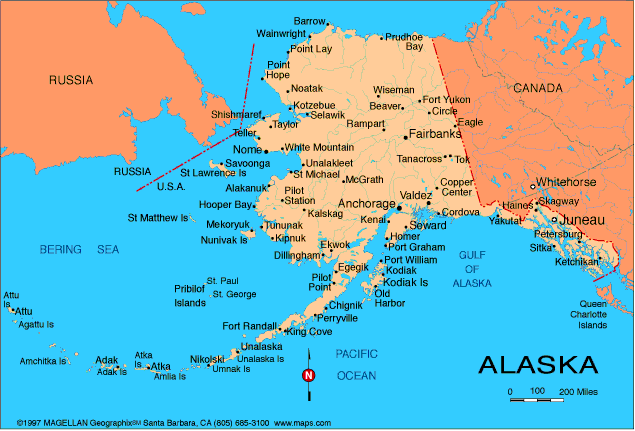Alaska, the largest state in the United States, is known as "The Last Frontier." This nickname reflects both its remote place and its untold, wild landscape. Accepted as the 49th state in 1959, Alaska was one of the last areas to join the Union, and most of its land is still underdeveloped. Alaska is home to breathtaking natural beauty and an extreme climate, with more than 663,000 square miles of rugged mountains, icy beaches, dense forests, and Arctic Tundra. The name "Last Frontier" is the symbol of a land that still has a sense of exploration, existence, and adventure. Alaska often involves a strong relationship with nature in life, in which many residents rely on hunting, fishing, and self-reliance. Its isolation, giant forest, and royal landscapes make it a symbol of the unknown and unexplained, a last side of America where nature still dominates urban life.
Check Out: Which U.S. States Border the Most States? Check the Full List and Geography
Alaska: The Last Frontier State

Alaska is a land of contradictions and extremes, offering some of the world's most dramatic scenarios. From the southeast's icy forests to the huge tundra of the north, its geography is as diverse as it is breathtaking. The state is the longest mountain in North America, and Denali is home to over 3 million lakes.
Its beach is longer than all other American states. Alaska experiences extreme weather - in the summer daylight and dark, especially in areas above the Arctic circle. Despite its harsh climate, Alaska supports a rich ecosystem, such as wildlife such as grizzly bears, wolves, caribou, and whales.
Indigenous communities such as the Inupiat and Yupik have lived here for thousands of years and rely on traditional knowledge to survive in an extreme environment. Alaska is not just a state - it is raw, unpublished nature and an experience of human flexibility.
Why is Alaska Called the Last Frontier?
Here are some of the major reasons behind the title “The Last Frontier given to Alaska:
1. One of the Last Territories to join the U.S.
Alaska became the 49th state of the United States in 1959, making it one of the last to achieve statehood. Earlier, it was an American region purchased from Russia in 1867. Its late entry into the union contributes to the "final frontier" identity, which symbolizes the final expansion of the American mainland.
2. Vast, Unexplored Forest
Alaska is home to a large-scale undeveloped land of of over 663,000 sq miles, including glaciers, mountains, tundra, and forest. Most of the state is still very sparsely populated and untouched, making it feel like a true boundary where nature remains prominent.
3. Hard Climate and Remote Life
With extreme weather, long winters, and remote communities, Alaska represents a place where people should be flexible and self-sufficient, much like early American pioneers. Many regions are accessible only by wind or sea, which strengthens its "edge of the world" image.
4. Spirit of Exploration and Survival
Alaska is a symbol of the spirit of adventure work, where outdoor existence, exploration, and living close to nature are part of everyday life. This marginal lifestyle reflects a deep-rooted American ideal of freedom and cruelty.
5. Cultural and Historical Importance
The name "The Last Frontier" is also an indication of the American Frontier era, provoking images of unwanted regions, opportunities, and raw beauty. It is a romantic symbol of the last chapter in the west side and the ongoing challenge of human vs. nature.
Comments
All Comments (0)
Join the conversation